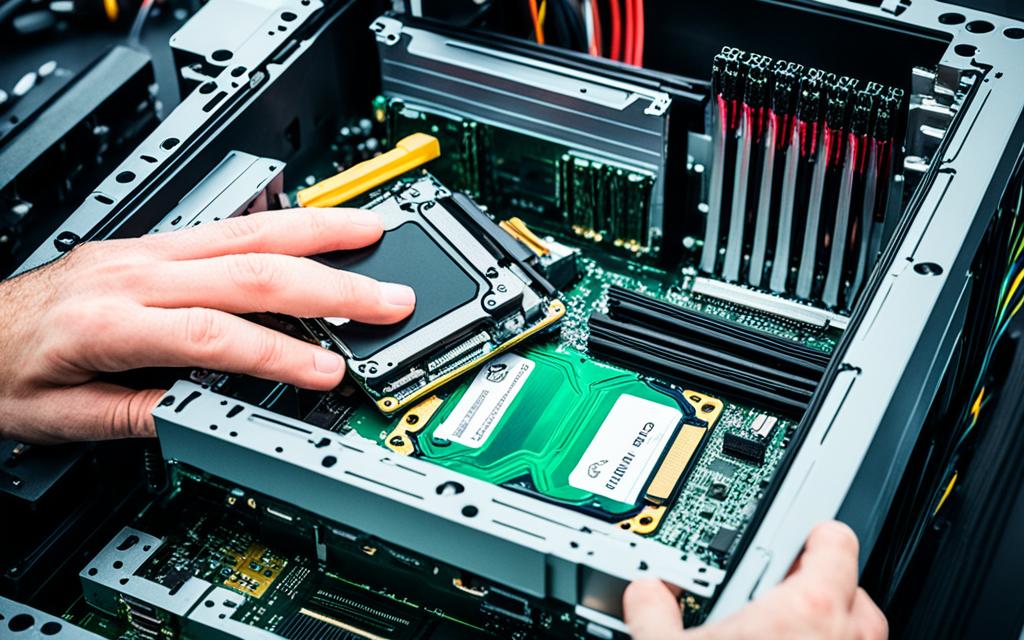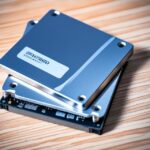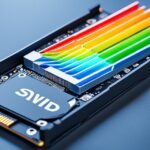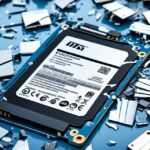Table of Contents
As technology moves forward, we all want our computers to run faster and smoother. Adding a second SSD is a great way to speed up your computer. It gives you quick access to data, speedy start-ups, and more efficient performance. This guide aims to help Windows users feel confident about upgrading their computer with a second SSD.
Nowadays, most computers use SSDs because they are much faster and more durable than old HDDs. For instance, SSDs can be up to ten times quicker than HDDs. This makes them a top pick for boosting your system’s speed1. We’ll guide you through every step to ensure you know how to add a second SSD and make the most of it.
If you want more storage or to make your computer run better, this guide has what you need. With the right tools and advice, upgrading to an SSD is straightforward.
Key Takeaways
- Installing a second SSD can significantly boost your computer’s performance.
- SSDs offer faster data access times, quicker application load times, and better overall responsiveness.
- Preparation is key—ensure you have the right tools and compatibility checks done.
- Using reliable cloning software can simplify data transfer when upgrading your “storage.
- Upgrading to SSD can enhance the longevity of older systems.
Introduction to SSDs
Getting to know about storage mediums is key if you’re thinking about an SSD upgrade. SSD stands for solid-state drive, which is a type of storage that uses flash memory. It’s way faster at accessing data than the older hard disk drives (HDDs). What’s cool about an SSD is that it’s not only speedier but also uses less power. That’s why it’s become super popular in newer computers.
What is an SSD?
An SSD is a big leap forward in how we store our data, thanks to flash memory. It doesn’t have any moving parts like HDDs do, so it’s all digital. This means it can fetch and save your data super quick. You’ll see your computer starting faster and running smoother. That’s a big win for anyone, whether you love games or need to get work done fast.
Benefits of Upgrading to an SSD
Switching to an SSD has loads of perks that make your computer experience way better. It makes everything faster – your start-up, opening files, and even loading programs don’t take as long. With SSDs, your computer can handle more tasks at once. This is perfect as files get bigger and programs ask for more from your system. Thinking about making the switch? Check out this helpful guide on installing an SSD2. Plus, getting the lowdown on SSD benefits is smart before you upgrade. For more on this, peek at another great resource on installing SSDs3.
Why You Should Consider Adding a Second SSD
The computing world is always changing. Adding a second SSD can make a big difference in your experience. Let’s look at the reasons to add second SSD. We will discuss the benefits of additional SSD and the overall SSD storage advantages.
Increased Storage Capacity
Adding an extra SSD means more space for your stuff. A 1TB SSD costs between $30 to $50. This lets you keep lots of files, videos, and apps without running out of space1. You can use one SSD for your system and another for everything else. This setup is popular for its neat organization4.
Enhanced Speed and Performance
Add a second SSD and your computer works much faster. SSDs are way quicker than the old HDDs, making your computer start faster and apps run smoother1. Having two SSDs, like in a RAID1 setup, boosts speed and makes everything more responsive. This is great for gaming or making content4.
Improved System Longevity
Two SSDs also mean your storage can last longer. Spreading out the data helps avoid overworking one drive. This can make them last longer and work better1. This smart setup keeps your system stable. It promises a high performance for a long time.
Preparing to Install Your Second SSD
Before you start installing a second SSD, get ready first. You need to collect the right tools and check if your computer can handle another drive. Doing this makes the installation go smoothly.
Gathering Necessary Tools and Components
Begin by gathering everything you need for the installation. Here’s what you’ll need:
- A new SSD that fits your system
- A SATA data cable
- A fitting power connector if necessary
- A screwdriver to open your computer case
Make sure your computer has space for another SSD and that your motherboard has a free SATA port5. Being prepared helps avoid any problems later on.
Compatibility Checks for Your Computer
Checking if your computer can take a new SSD is key. Look at the following:
- Is there room in your case for another drive?
- Is there an unused SATA port on your motherboard?
- For laptops, check if there’s space or needed connectors.
- You might need a SATA controller or a Molex adapter for extra ports.
Be careful of static electricity when installing your SSD. Using an anti-static wrist strap is a good idea. Following these steps helps ensure a successful installation6.
| Component | Importance |
|---|---|
| New SSD | Primary upgrade for storage |
| SATA data cable | Necessary for connecting the SSD to the motherboard |
| Screwdriver | Essential for accessing the case and securing the SSD |
| Anti-static wrist strap | Prevents static discharge damage |
By following these tips, you’re all set for installing your second SSD. This upgrade will boost your computer’s storage and performance5.
How to Install a Second SSD
Adding a second SSD boosts your system’s speed and space. This guide shows you how to install an SSD easily. It highlights key steps and tips. These will help you avoid usual errors people make during the installation.
Step-by-Step Installation Process
First, turn off your PC and unplug it. This is important for keeping your hardware safe. Then, open your case to find a free drive bay. The SSD must fit perfectly for everything to work right. Most cases have several spaces for extra SSDs5.
If needed, take out the caddy, put the SSD in, and screw it tight. Now, link a SATA data cable from the SSD to the motherboard. Also, connect a power cable from the supply to the SSD. If installing in a laptop, check the manual for how to open it7. Lastly, put the case back and plug in the power.
Common Installation Mistakes to Avoid
Don’t connect cables loosely as it can cause problems later. Always check if the SSD fits your system before buying. Avoid leaving electricity in the system. Press and hold the power button for five seconds before starting7. These tips keep your parts safe. If there’s no room on your motherboard for more cables, consider getting a SATA controller that fits into a PCI or PCIe slot5. And, using data migration software makes changing drives easier7.
| Common Mistakes | Solutions |
|---|---|
| Loose cable connections | Ensure all cables are securely connected |
| Ignoring compatibility | Verify the specifications of the new SSD |
| Residual electricity presence | Hold down the power button for five seconds |
| Not using data migration software | Use suitable cloning software for SSD replacement |
| Improper SSD fitting | Make sure SSD fits snugly in the drive bay |
By taking these careful steps and dodging common installation errors, your system’s upgrade is easily achievable7.
Initialising Your New SSD
Once your new SSD is in place, the next step is to get it up and running. This means initialising it so Windows can recognise and use it.
Using EaseUS Partition Master
Initialising your SSD is simple with EaseUS Partition Master. Just open the software and right-click on the SSD. Choose GPT or MBR for your partition style. Your choice should match your system, with GPT being better for newer setups.
After picking your options, carry out the task. This saves your choices and finishes the initialisation. EaseUS also has many features for managing your partitions, perfect for any user level8.
Using Windows Disk Management
Windows Disk Management is a great option if you like using built-in tools. Just open it, find your SSD, and right-click it. Then hit ‘Initialise Disk’. Make sure your settings are correct to avoid losing files.
Next, set up a new volume and choose NTFS for the best compatibility and speed. This method prepares your SSD quickly and blends well with your system9.
| Partition Style | Capacity Support | Compatibility |
|---|---|---|
| GUID Partition Table (GPT) | Supports volumes larger than 2TB | Recommended for UEFI-based systems |
| Master Boot Record (MBR) | Limited to 2TB volumes | Used by older systems and removable drives |
Want more tips on boosting your PC? Check out detailed instructions here10.
Optimising Your Second SSD for Use
To get the most from your second SSD, follow SSD optimisation tips. This includes partitioning the SSD and choosing the right file system for SSD.
Partitioning Your SSD
Partitioning your SSD helps it perform better and stay organised. It lets you divide the drive into sections to sort files and apps. This is vital for people into gaming and digital marketing, as their storage needs keep growing11. In fact, about 75% find storage limits a problem because of larger files and doing many things at once.
Choosing the Right File System
Picking the best file system is crucial for good data storage and access. NTFS is recommended for its flexibility with Windows, especially for large installs. For use across different devices, consider exFAT. Nowadays, almost 90% of laptops can add a second SSD11. It’s also wise to check the SSD’s condition regularly to ensure it stays in top shape12.
Conclusion
Putting a second SSD in your computer offers key benefits. It boosts storage and performance. This isn’t just about more space. It means your PC starts faster, files open quicker, and it runs better during heavy tasks like playing games or editing videos. tried>
The steps to install and get the most out of a new SSD are now clear. Knowing how a second SSD helps lets you make smart choices. Choices that enhance your use of technology. You can enjoy all that advanced storage tech offers13.
Starting this upgrade journey improves your computer’s life and performance. You tackle storage issues and prep for a better computing experience. This supports today’s digital needs and applications1415.
FAQ
What is the difference between an SSD and an HDD?
SSDs, or solid-state drives, store data using flash memory. This makes them faster and more reliable than HDDs. Hard disk drives (HDDs) use spinning disks to store data, which is slower.
Do I need special tools to install a second SSD?
You’ll mainly need a screwdriver to install an SSD. Make sure you have a SATA data cable and a power connector. Also, check for available SATA ports and space in your computer case.
Is it safe to install a second SSD myself?
Yes, you can safely install an SSD yourself. Make sure the computer is off and not connected to power. Also, protect against static electricity when handling internal components.
How do I know if my motherboard supports a second SSD?
Look at your motherboard’s specs for available SATA ports and drive bay configurations. Most modern ones support multiple SSDs. It’s wise to confirm this first.
How can I optimise my new SSD for performance?
Divide your SSD into sections and choose NTFS for a better fit. Stay up to date with firmware updates. Use tools like EaseUS Partition Master for help.
What file system should I use for my new SSD?
NTFS is best for Windows users for peak performance. For using your SSD across different devices, exFAT is a good choice, especially for external drives.
What should I do if my SSD is not detected after installation?
Ensure all cables are connected properly and the SSD is in the right bay. You might need to initialise the SSD using tools like Windows Disk Management or EaseUS Partition Master.
Will installing a second SSD void my warranty?
It depends on the warranty terms of your device’s manufacturer. Adding an SSD usually doesn’t void a warranty. But it’s best to check your manufacturer’s specific terms.
Source Links
- https://www.backblaze.com/blog/ssd-upgrade-guide/ – How to Upgrade Your Computer: Migrating from HDD to SDD
- https://www.instructables.com/Add-a-Second-SSD-to-a-Dell-Latitude-E5470-Laptop/ – Add a Second SSD to a Dell Latitude E5470 Laptop.
- https://forum.manjaro.org/t/make-second-internal-ssd-usable/137985 – Make second internal SSD usable
- https://community.spiceworks.com/t/two-ssd-or-not-two-ssd/391229 – Two SSD or not two SSD?
- https://www.lifewire.com/install-a-second-ssd-5071696 – How to Install a Second SSD
- https://www.easeus.com/partition-master/how-to-install-a-second-ssd.html – How to Install a Second SSD[Comprehensive Guide]
- https://www.crucial.com/articles/about-ssd/how-to-install-ssd-in-laptop – How to Install an SSD in a Laptop
- https://www.easeus.com/partition-manager-software/initialize-a-hard-drive-ssd.html – How to Initialize SSD in Windows 10/8/7
- https://www.makeuseof.com/how-to-initialize-ssd-windows-10/ – How to Initialize an SSD in Windows 10
- https://learn.microsoft.com/en-us/windows-server/storage/disk-management/initialize-new-disks – Initialize new disks
- https://www.ubackup.com/windows-11/how-to-install-second-ssd-windows-11-6007-ac.html – Ultimate Guide: How to Install a Second SSD on Windows 11
- https://4ddig.tenorshare.com/hard-drive/how-to-install-a-second-ssd.html – How to Install a Second SSD? [Easy Tutorial in 2024]
- https://www.ubackup.com/articles/how-to-install-a-second-hard-drive-in-windows-10.html – Install a Second Hard Drive in Windows 10 (One-Stop Wizard)
- https://askubuntu.com/questions/1033497/dual-boot-windows-10-and-linux-ubuntu-on-separate-ssd – Dual Boot Windows 10 and Linux Ubuntu on Separate SSD
- https://www.easeus.com/partition-manager-software/install-windows-10-on-second-hard-drive.html – How to Install Windows 10 on Second Hard Drive | 2 Ways🔥








